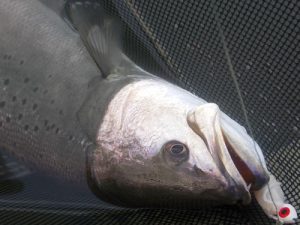
It can be argued that the speckled trout is the most beautiful fish that occurs in the Chesapeake Bay. Except for its prominent black spots, this member of the croaker family is similar in appearance to the gray trout (weakfish).
In the Chesapeake Bay, speckled trout orient to very specific habitats and are rarely caught outside of these areas. Specks are most often associated with shallow areas where aquatic grasses are found. They are also caught along the shoreline near mouths of creeks and rivers.
Some of the best known areas for catching speckled trout in the Chesapeake Bay are found on the eastern side of the estuary, from the Choptank River down to the Tangier and Pocomoke Sounds. Speckled trout also occur along Virginia’s Eastern Shore, and in the lower sections of the Potomac, Rappahannock, York, and James Rivers.
In many of these areas, widgeon grass, eelgrass, and other submerged aquatic grasses grow on the bottom in great quantities. Other areas contain a mix of grass beds, ancient stumps, oyster bars, and sandy open bottom. These habitats tend to hold immense numbers of crabs, shrimp, forage fish, and other species that speckled trout feed on.
Anglers often spend considerable time searching for prime speckled trout habitats. Some fishing spots are well known, while others are shrouded in secrecy. To aide in locating areas where specks are abundant, fishermen now have a variety of tools including online fishing communities, satellite imagery, GPS navigation, and other technology.
Anglers rely on a variety of techniques for catching speckled trout in the Chesapeake Bay, Some fishermen prefer to fish with cut bait while others cast or troll artificial lures. Specks are also targeted by fly fishermen using a variety of saltwater fly patterns.
In most areas, the best baits for catching speckled trout include peeler crabs, soft-shelled crabs, fresh shrimp, bloodworms, and cut fish. Under certain conditions, anglers may use live spot or other small fish to target trophy-class specks. Bait choices sometimes depend on local conditions.
For example, when soft crab runs occur in shallow grassy areas, cut peelers or soft crabs may be essential for catching specks. During other periods, when trout are mainly feeding on baitfish, cut spot or live baits may be more effective.
When choosing artificial lures for catching speckled trout, anglers also match their tackle to mimic local baitfish. In many parts of the Chesapeake Bay, the most abundant food sources are bay anchovies, killifish, menhaden, spot, and white perch.
The most popular lures tend to be simple jigs rigged with soft plastic bodies. Some anglers prefer grub-style or slender bodies, while others fish with small shad bodies. Bucktail-type jigs are also popular, especially when combined with lure bodies or bait strips. Other popular lures include small spoons, metal jigs, swimming plugs, and surface poppers or chuggers.
One of the most popular techniques for catching specks is to cast lures along points, edges of grass beds, or other structure. Some anglers troll slowly along these same areas in order to cover a large area. Because most of the fishing occurs in very shallow water, small boats are often preferred. When launch sites are available near prime fishing areas, anglers may also use kayaks or other small boats while speckled trout fishing.
Related Information